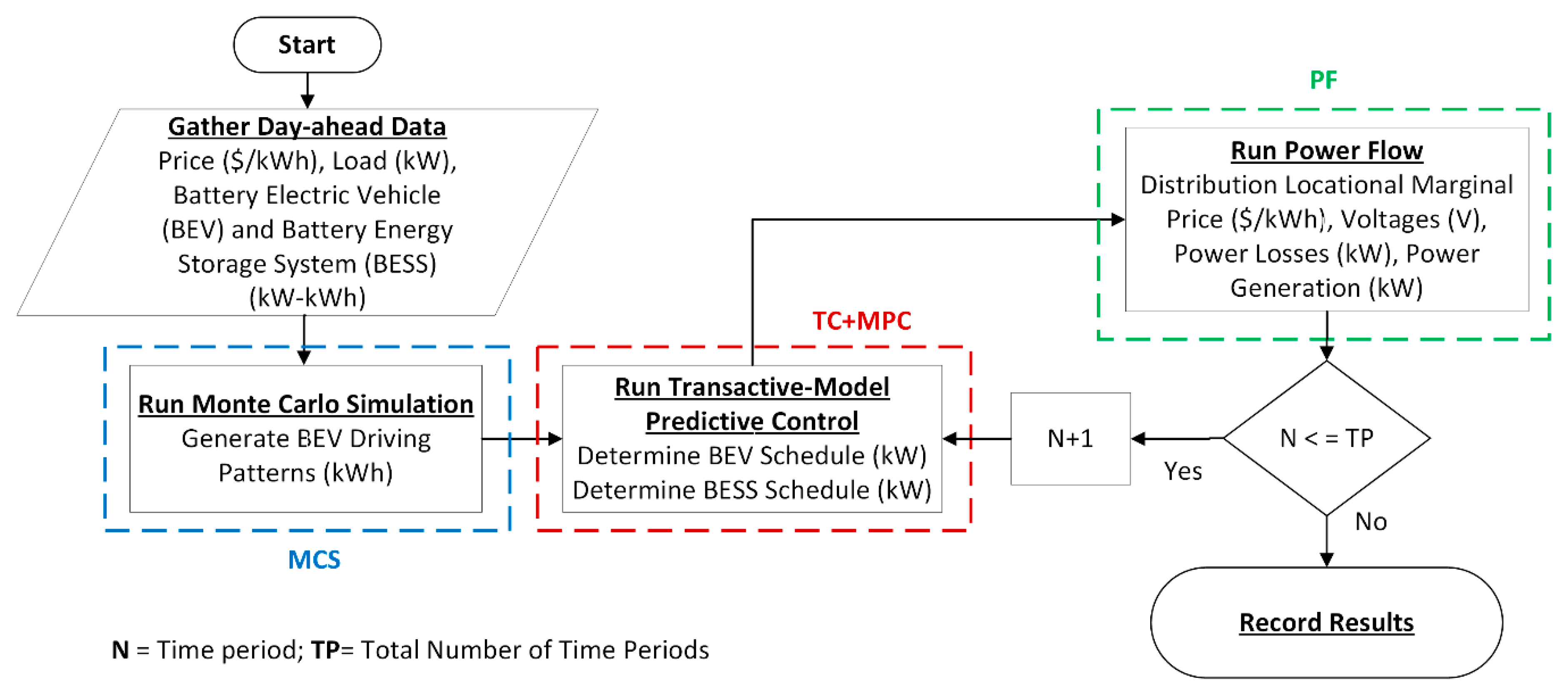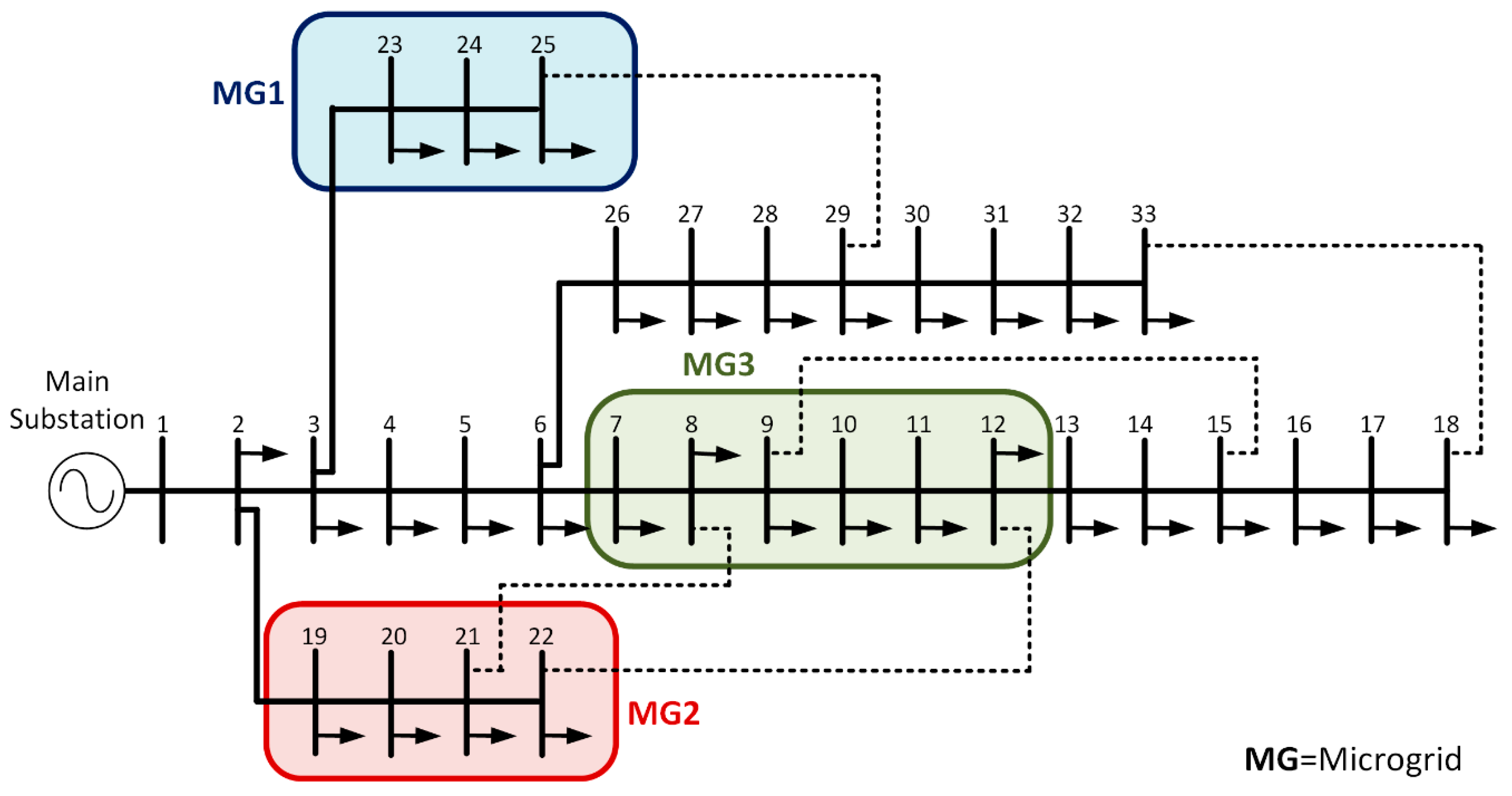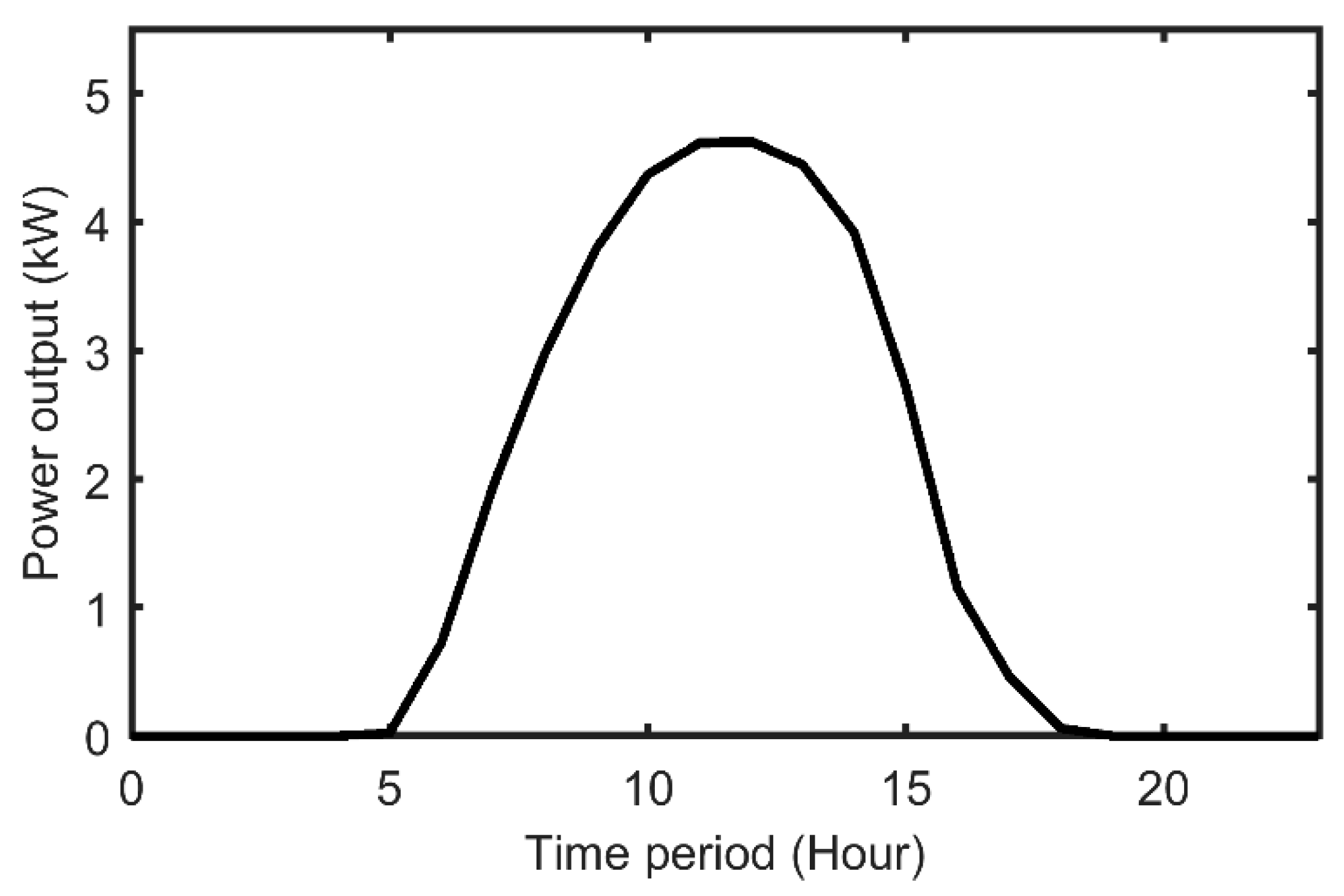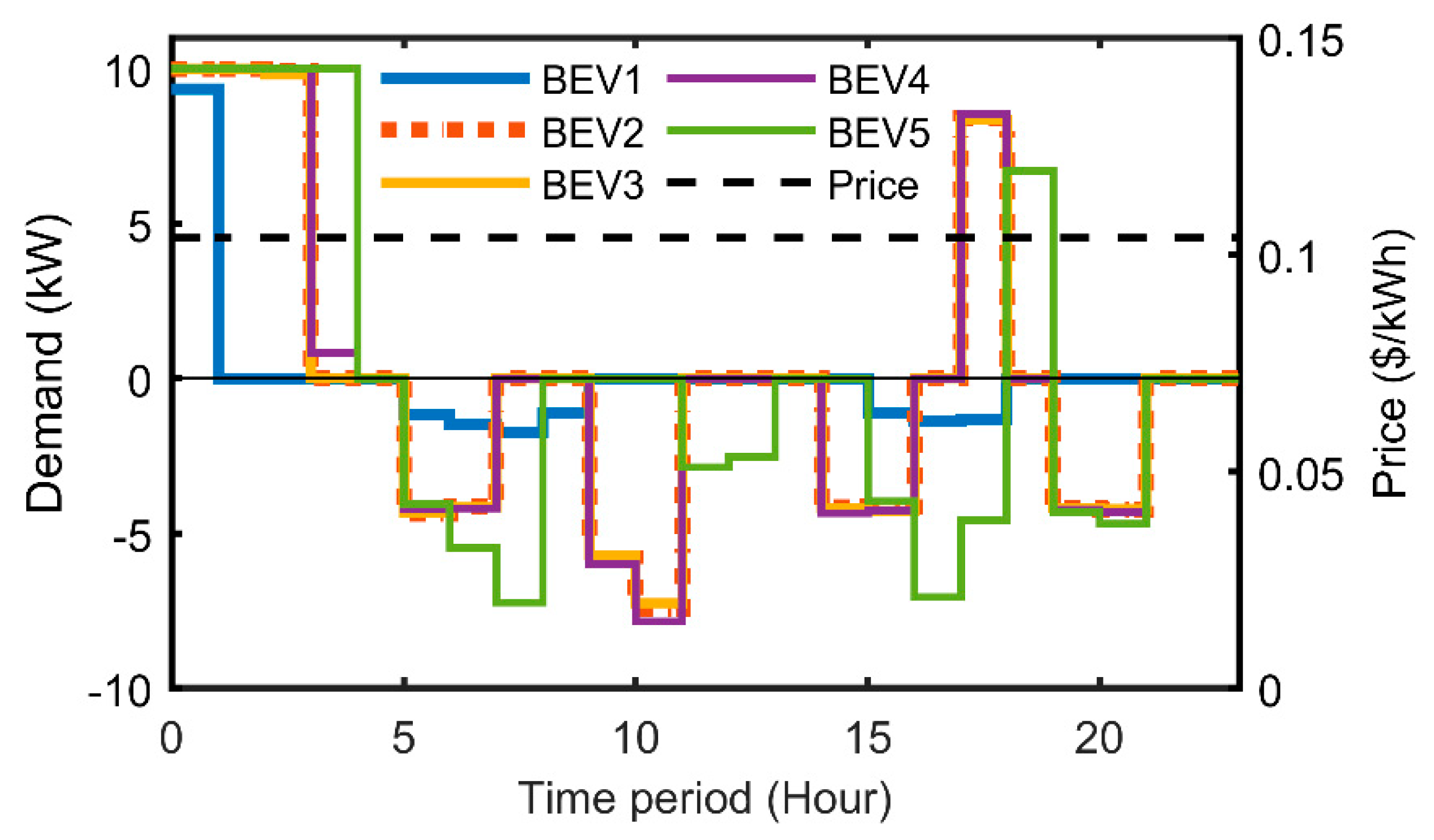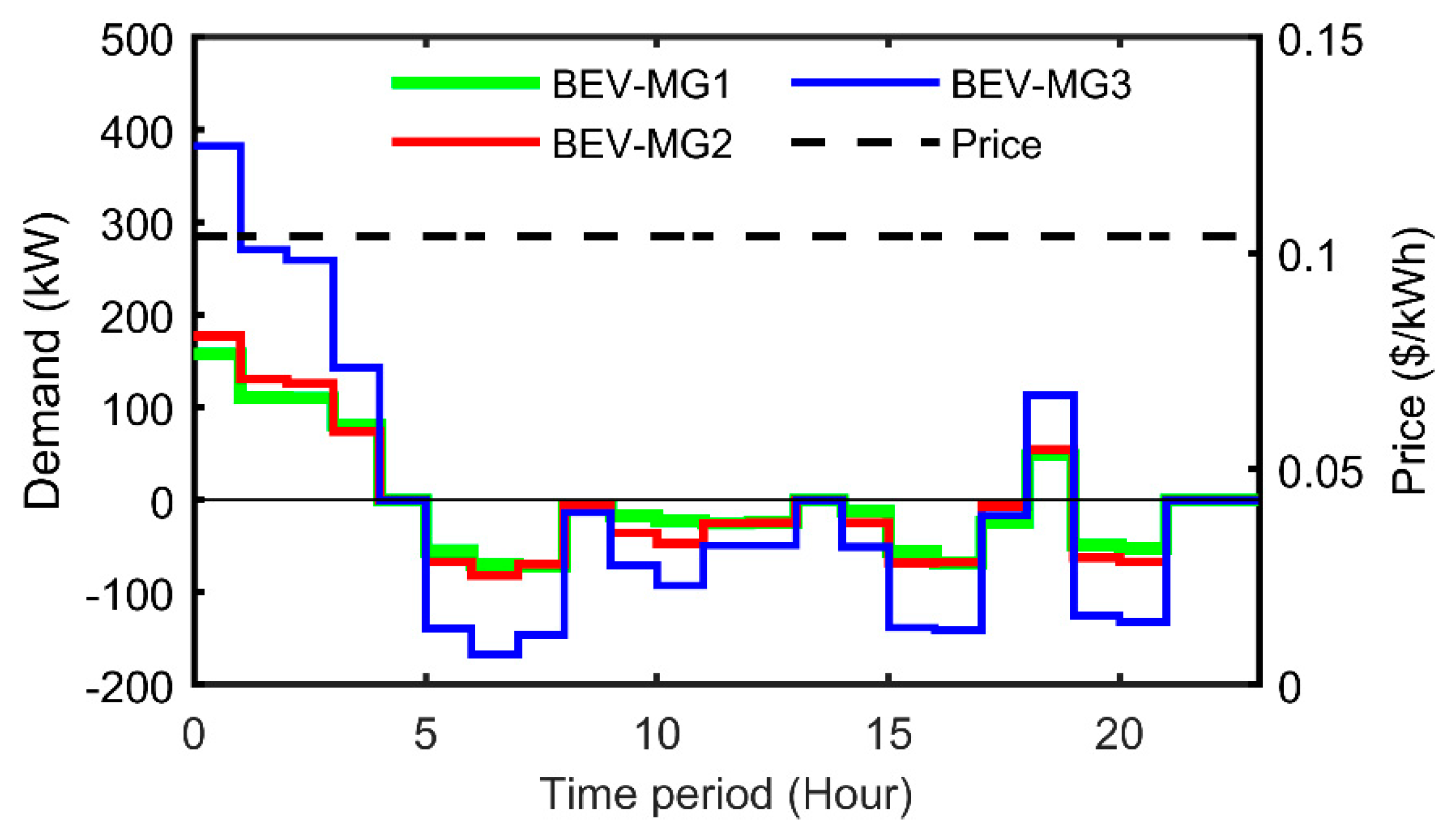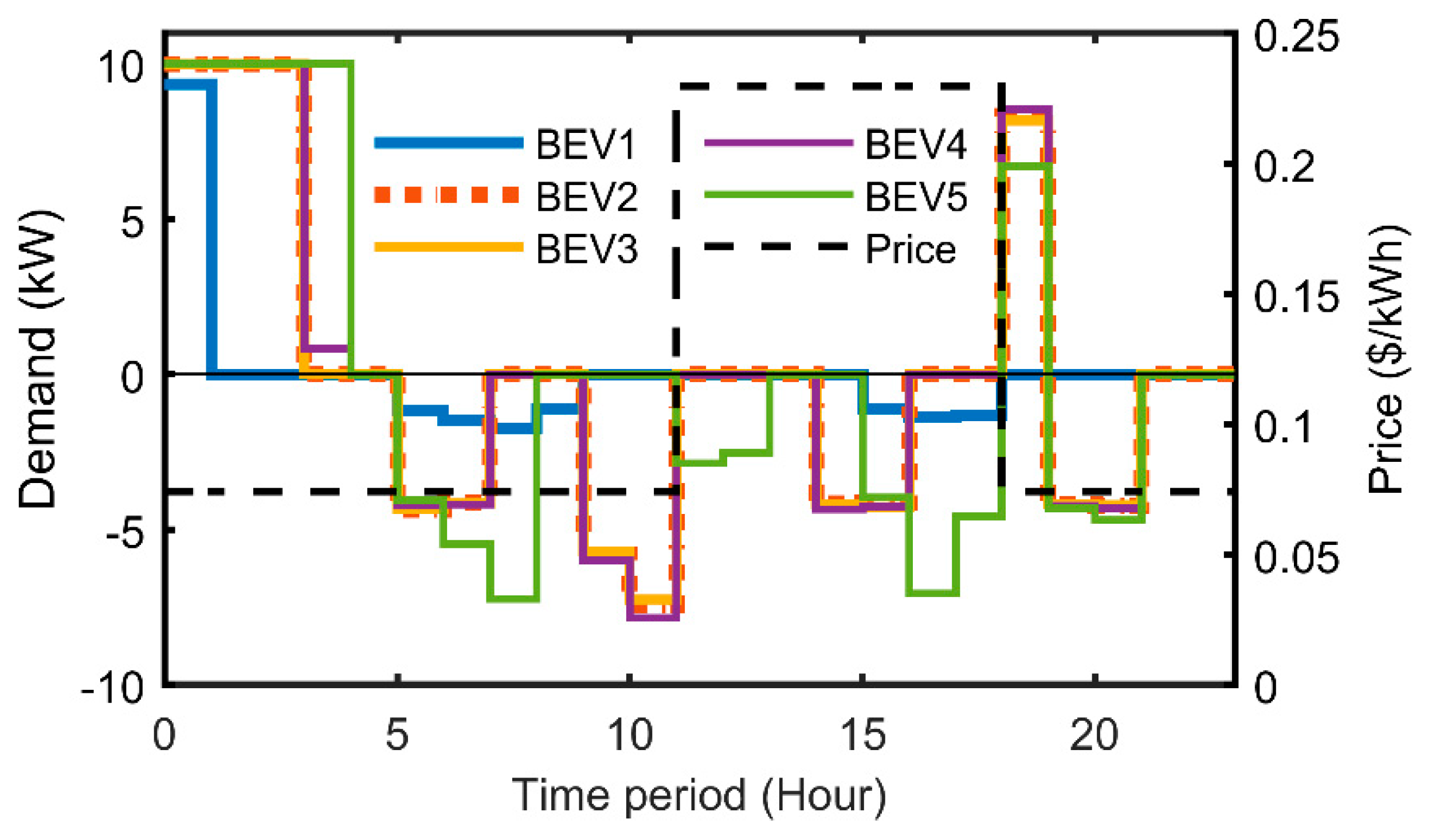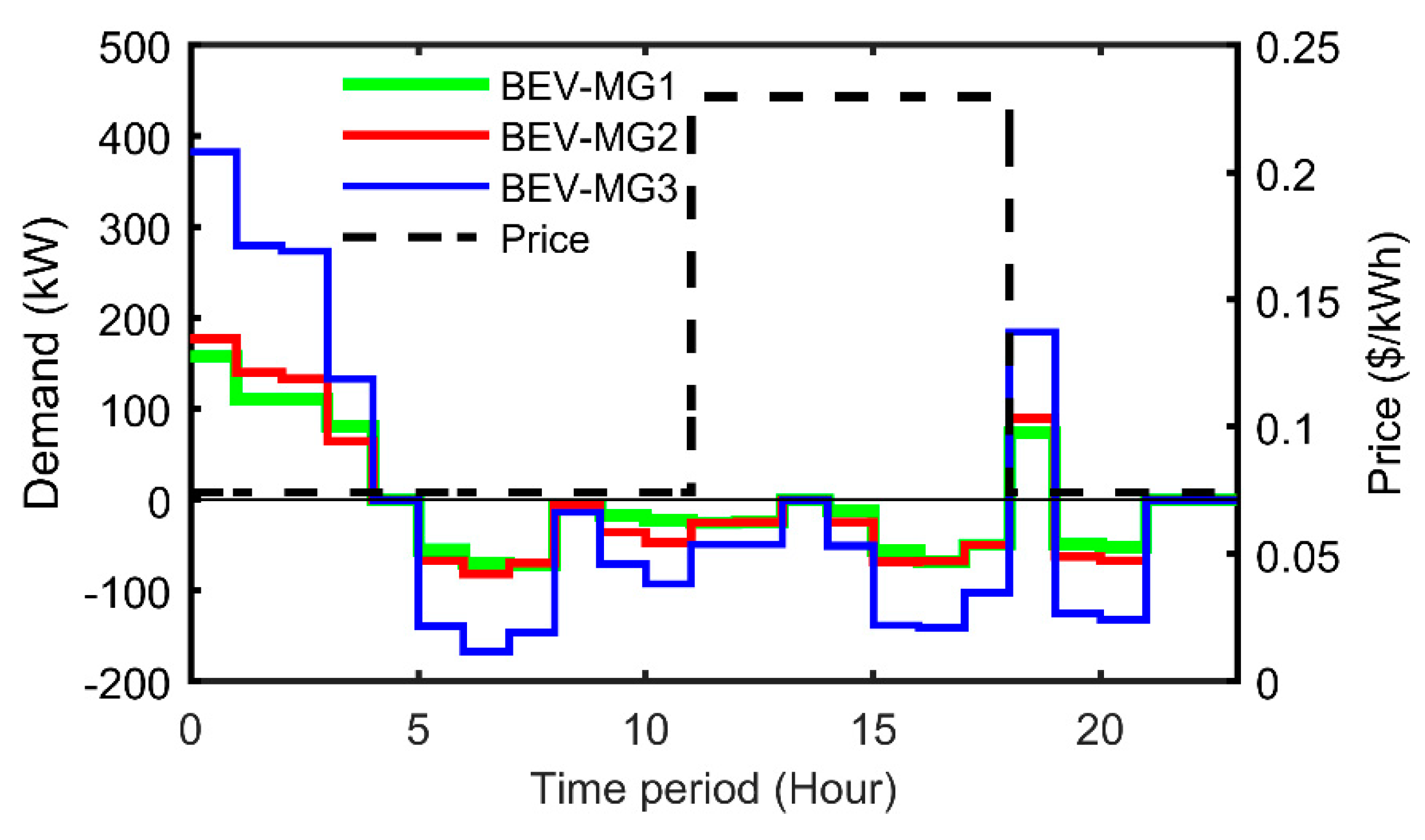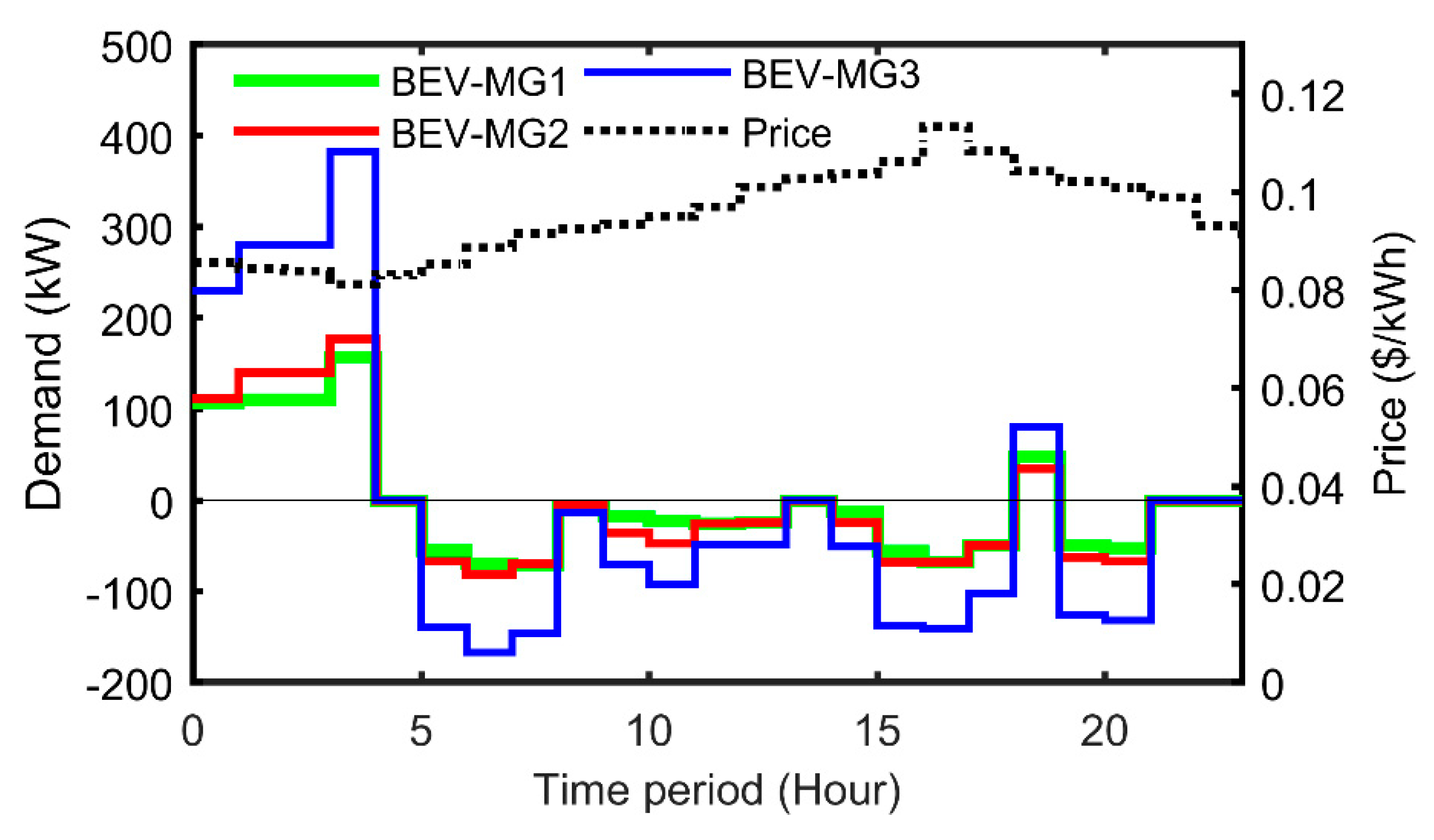1. Introduction
Over the past years, technological developments have driven an increase in distributed energy resources (DERs) across the distribution network, particularly at the demand side. DERs are changing the electrical landscape from a conventional demand-driven power grid to a transactive supply following energy system, where customers (as electricity consumers and/or producers) are actively engaged in transactions and participate in the operation and management of the power grid [
1,
2,
3]. Although the overall installed capacity of DERs is still significantly low, projections indicate a ramp-up in the coming years. According to the U.S. Energy Information Administration (EIA), solar photovoltaic (PV) generation at the distribution level (utility-scale and small-scale) has grown 232% over the past five years (2014–2018), going from a total net generation of 28,925 MWh in 2014 to 96,147 MWh in 2018 [
4]. Moreover, the EIA in its 2019 annual energy outlook projects that electricity generation from solar PV will reach 15% of total U.S. electricity generation by 2050 [
5].
On another front, transportation has also been experiencing important changes around the world. According to the international energy agency (IEA), in 2017, a new milestone was reached with more than 3 million battery electric vehicles (BEVs) on the road worldwide [
6]. Furthermore, the same report projects the worldwide BEV fleet to reach 13 million and 130 million by 2020 and 2030, respectively. Thus, it can be seen that, in the next few years, the increase in BEVs and solar PV generation will cause various integration challenges on the electric grid. The current power grid was not designed to host the increase of load caused by BEV charging and power-flow fluctuations caused by solar PV generation, especially low-voltage distribution networks.
In this regard, Microgrids (MGs), as shown in
Figure 1, are considered a key asset of the power grid of the future as they can be used to manage the increasing levels of DERs [
7]. MGs are autonomously managed and powered sections of the electrical distribution grid that can be as small as a single building or as large as a downtown area or neighborhood. MGs equipped with advanced communication and control technology can enable coordination between the distribution system and other MGs. Networking of multiple MGs (networked MGs), also known as community MGs, MG cluster, or MG clustering, share a common geographic region and can provide a variety of benefits, e.g., increased efficiency, reliability, and resiliency. Moreover, in the future smart grid, networked MGs could help mitigate the variability of DERs and allow consumers and prosumers to transact and exchange energy (i) among each other and (ii) with other MGs and (iii) to participate in a local retail market providing ancillary services with the rest of the distribution system [
8].
Different approaches are proposed in the existing literature to manage and control networked MGs [
9,
10,
11,
12,
13,
14,
15,
16,
17,
18]. The role of networked MGs as distributed energy systems to improve power-grid resiliency during extreme weather events is analyzed in Reference [
9]. In Reference [
10], a multilayered control architecture based on a large-signal model has been proposed to regulate voltage magnitude and frequency as well as output power of DERs within networked MGs. Primary frequency control to support switching transients for networked MGs is reported in Reference [
11]. A method for energy-storage dispatch and renewable energy resource sharing in a network of grid-connected MGs to reduce electricity costs is presented in Reference [
12]. Shi et al. [
13] proposed a distributed energy management strategy formulated as an optimal power-flow problem for the optimal operation of MGs with consideration of the distribution network and the associated constraints. A priority-based energy scheduling mechanism for distribution networks with multiple MGs is described in Reference [
14]. Gregoratti and Matamoros [
15] addressed a multiple-MG energy-trading strategy in order to minimize the global operation cost while satisfying local energy demand of MGs. A most valuable player algorithm is presented in Reference [
16] to optimize the scheduling of the generation units and battery storage of an MG. In Reference [
17], a distribution grid service market is proposed to provide voltage stability services in MGs. A demand-side management scheme for cost minimization in a residential MG using strawberry and cuckoo search algorithms is discussed in Reference [
18].
Although network-MG control and management has been widely studied [
7,
8,
9,
10,
11,
12,
13,
14,
15,
16,
17,
18], many of these studies fail to analyze the impacts that these approaches might have on conventional distribution networks. As in some cases, the distribution network is not considered [
12,
15] and in other cases, a simplified version is considered [
10,
11,
13,
14]. Thus, some of the solutions obtained from the aforementioned algorithms might be infeasible in practice. Also, most of these studies fail to consider customer willingness to participate in their control strategies, assuming customer participation as a given, i.e., no incentives are offered for customer participation. A transactive control (TC) approach can be used to incentivize customer participation and to help manage DERs in an MG.
A TC is a market-based distributed mechanism that can combine multiple objectives and constraints using uniform transactive incentive signals (TIS) and transactive feedback signals (TFS) [
1]. These signals propagate through a communication network where the TC is embedded in the electrical network. TIS and TFS are two different signals with TIS representing the actual delivered cost of electric energy (
$/kWh) and TFS dealing with the net electric load (kW) at a specific system location. In recent years, TC-mechanism use in smart grids and MG applications has been studied due to its potential for an efficient DER management and the creation of opportunities to engage in transactions between the different entities that constitute the electrical distribution system, e.g., electric utility and customers. A review of the state-of-the-art of transactive energy systems and concepts are presented in Reference [
19]. The potential benefits of TCs were reported in the Pacific Northwest Smart Grid Demonstration project, where the TCs were functional and operational in a variety of pilot projects ranging from MG applications up to wholesale market level transactions [
20]. In Reference [
21], a transactive bilateral energy-trading mechanism is proposed to minimize the costs for individual participants and to ensure the reliability and security of the distribution system, where Nash bargaining theory and alternating direction method of multipliers (ADMM) are used to model the problem. A multi-agent transactive energy-management framework for networked MGs is presented in [
22]. The multi-agent system manages energy imbalances in the MGs, using demand response and battery energy storage systems (BESS) with the objective of minimizing the costs for MG customers. A multi-agent system is also proposed in Reference [
23], where an auction-based locational marginal price (LMP) is used to motivate the energy transactions among MGs. In Reference [
24], a day-ahead transactive market framework is proposed for DER scheduling to reduce local supply costs. TCs are used for BEV charging in References [
25,
26,
27]. A TC based on model predictive control (MPC) is used for real-time scheduling of BEVs in Reference [
25], where the MPC is used to clear a day-ahead transactive market. In Reference [
26], the charging demand of the BEV is used to manage uncertainties of the building PV generation. Hu et al. [
27] implemented a TC with the purpose of minimizing the BEV-charging cost as well as of preventing grid congestion and voltage violations. A reactive power incentive program to maintain distribution-system reliability is presented in Reference [
28]. In Reference [
29], a Nash bargaining formulation is proposed for energy trading between networked MGs for MG operation cost reduction. A TC coupled with a pricing rule is proposed for grid-connected, islanded, and congested networked MGs in Reference [
30]. DC MGs have also been studied for application of TCs [
31,
32,
33]. In Reference [
31], a framework is proposed for short-term operation of DERs, controllable demands, and MGs in a transactive energy architecture, with a focus on the distributed energy management of hybrid AC/DC microgrids. Jingpeng et al. [
32] presented a centralized energy-management system approach based on transactive energy to reduce the total operation cost and to achieve efficiency in a DC residential system. In Reference [
33], a transactive energy-management system for supply/demand coordination with demand response programs was implemented to manage rural DC MGs.
Several other models have been proposed for BEV charging/discharging and pricing scheduling [
34,
35,
36,
37,
38,
39]. The impact of variable prices on the behavior of BEV users is studied in Reference [
34], where the variable prices are determined based on the calculation of distribution locational marginal price (DLMP) and updated continuously based on the users’ trips and behavior. In Reference [
35], an optimal Time-of-Use (TOU) schedule and a controlled BEV-charging algorithm are used to maximize both customer and utility benefits, and a controlled charging algorithm is also proposed to improve thier voltage quality at the EV load locations while avoiding customer inconvenience. In Reference [
36], meta-heuristic techniques are used for charging coordination of BEVs with simultaneous operation of capacitor switching to minimize power losses and voltage deviation in a distribution system. Furthermore, a TOU electricity tariff was included in the proposed charging coordination to reduce the PEV charging cost. Cherikad et al. [
37] proposed a distributed dynamic pricing model for BEV-charging and -discharging scheduling and building energy management in an MG. Their model consisted of a cloud-software defined networking communication architecture and a linear optimization approach to achieve efficiency in the MG. Pasetti et al. [
38] proposed a model to estimate the price of BEV charging considering the impacts solar PV generation has on the charging costs of BEVs. The model estimated the costs considering demand charges and utility loss of revenue and was compared to a TOU tariff. In Reference [
39], a two-stage real-time optimization algorithm is proposed to recharge a fleet of plug-in BEVs to minimize costs, to avoid creating new peaks in the demand profile, and to improve use of power system equipment. The optimization algorithm used a dynamic price signal based on probabilistic models developed using historical price data.
Motivated by the promising benefits of using TCs, this paper proposes a hybrid control mechanism based on the combination of TC and MPC for an efficient management of DERs in prosumer-centric networked MGs. Hereinafter, the proposed control approach is termed TC+MPC. This paper further presents a detailed analysis of the impacts (economical and technical) produced by the TC+MPC within the MGs, and the distribution system as a whole is presented. To carry out this analysis, a Monte Carlo Simulation (MCS) is proposed to consider BEV driving uncertainties and the proposed hybrid TC+MPC management system is used to manage DERs. The hybrid TC+MPC combines the control capabilities and features of the MPC with the TIS–TFS signals of the TC, creating a robust control mechanism that is driven by price signals. The objective of the TC+MPC management system is to produce optimal BEV charge and solar PV-BESS charge/discharge schedules to significantly reduce the residential MG customers’ operational cost and to improve their overall savings. The proposed MG energy-management system (MGEMS) is evaluated considering different case studies and scenarios to analyze the impacts that BEV and PV-BESS systems can have on the distribution network.
To the best knowledge of the authors, the proposed hybrid control mechanism, i.e., TC combined with MPC and MCS, has not been applied in the area of networked microgrid energy-management systems, thereby advancing the state-of-the-art in controlling mechanisms for networked MGs. In contrast to the existing literature, the major contributions of this paper to the state-of-the-art are the following:
Development of a new hybrid TC+MPC control mechanism to manage DERs (BEVs, solar PV, and BESS) of networked MGs constituted by consumer groups (CGs) and prosumer groups (PCGs) and detailed study of their behavior while being incentivized by different price signals;
Development of TIS and TFS signals, where TIS is based on distribution locational marginal price (DLMP) and distribution system conditions, whereas TFS development is based on CG/PCG net load and BEV driving patterns generated by MCS.
Detailed analysis of the impacts on the distribution grid due to the use of TCs for DER management, i.e., bus voltage and power loss impacts.
Detailed cost/savings analysis for consumers/prosumers under different pricing rates when they are equipped with BEVs, solar PV, and hybrid solar PV-BESS systems.
In order to evaluate the proposed TC+MPC based energy-management system, five case studies (with and without PV/BESS and under different price signal scenarios) are conducted on residential networked MGs based on an IEEE 33-bus test system. The remainder of this paper is organized as follows.
Section 2 details the essential components of the proposed TC+MPC-based MGEMS with the uncertainty modeling and the incentive signal formulation. Numerical test results and discussion are presented in
Section 3, and
Section 4 concludes the paper.
3. Numerical Results and Discussion
In this section, case studies are presented to test the proposed hybrid TC+MPC scheduling method on an IEEE 33-bus radial distribution system. For simulation purposes, BEV penetration is considered based on the EV30@30 campaign [
44]. The EV30@30 campaign was launched at the Eighth Clean Energy Ministerial in 2017 in which the collective goal for all Electric Vehicle Initiative members is to reach a 30% market share for BEVs by 2030. In the case studies, a total of 242 households are assumed to be located in three MGs. Data from the US Census Bureau [
45] was used to estimate the number of households that own vehicles, and assuming a 30% BEV penetration, a fleet of 74 BEVs is considered to be distributed among the households located in each MG. Three BEV historical driving patterns are considered for the case studies [
40]. Detailed historical BEV driving data expressed in kWh is shown in
Table A1 in
Appendix A. For the simulation, 1000 scenarios are generated for each BEV type.
Table 1 shows the BEV parameters used to calculate the random components that are needed for generating BEV driving patterns by MCS.
The three MGs considered for the simulations are assumed to be located in a 33-bus radial distribution system, as shown in
Figure 3. The test system data was acquired and modified from Reference [
46] by placing three MGs along the feeders of the test system and by modifying the load values. Detailed bus load data for the 33-bus distribution system is shown in
Table A2 in
Appendix A. In
Figure 3, each bus represents a distribution transformer and the dotted lines indicate normally open tie lines. Connected to each transformer are sets of residential customers that are aggregated as CGs or PCGs depending on their classification, i.e., consumer or prosumer. The tie lines are not used in the case studies and are only kept to maintain the test system topology as described in Reference [
46].
To run the simulations, actual hourly data of load, PV power output, and electricity price have been used. Price data (fixed and time-of-use rates) were obtained from El Paso Electric, a utility in the U.S. southwest [
47,
48]. The LMP price data was obtained from Pennsylvania, Jersey, Maryland Power Pool (PJM) market [
49]. The load data was obtained from the U.S. Department of Energy Open Data Catalog, residential load at TMY3 locations for the surrounding region of Ashland, Oregon [
50]. The specific locations are Klamath Falls, Medford-Rogue Valley, and Redmond, all from Oregon. The solar PV power output data was obtained from a solar PV system located in Ashland, Oregon. The solar PV power output profile is representative of a sunny summer day.
Figure 4 shows the solar PV power output profile considered for each prosumer. The load data was selected for these locations to make the simulation more realistic as the PV power output is considered for the same region. Moreover, by using real load, price, and PV data, the case study results can better illustrate the potential benefits that can be achieved by using a TC+MPC for BESS and BEV management in residential networked MGs.
Most of the latest BEV models (2019 and newer) that are being produced have driving ranges above 200 miles and are equipped with batteries that have capacities between 60 kWh and 100 kWh [
51]. Furthermore, five of the top ten selling BEVs in the U.S. have battery capacities of 60 kWh or higher [
52]. Therefore, it is expected that newer BEV models will continue this trend which will become the norm in most distribution systems in the future. Hence, for BEV modeling, a Tesla Model S is considered [
53]. The Model S offers various battery capacity presentations; we considered the 70-kWh battery. It is assumed that the maximum charging power is 10 kW which is based on a 240-V, 40-A connection. A large-scale electric vehicle deployment project known as My Electric Avenue was conducted in the United Kingdom between January 2013 and December 2015 [
54] in which one of the major findings was that the likelihood of a BEV being charged when its initial SOC was 16.6% or lower is less than 15%. Another study conducted by the Idaho National Laboratory, U.S.A. found that the average percentage of users who started a commute or a charge with an SOC of 20% or lower is less than 5% [
55]. Thus, for simulation purposes, we assume the minimum and maximum BEV SOCs to be 20% and 100%, respectively. The BESS considered for the simulations is a Tesla Powerwall [
56]. The PowerWall battery has a capacity of 13.5 kWh and a charging/discharging power of 5 kW. The minimum and maximum BESS SOCs are set as 0% and 100%, respectively. The information regarding the BEVs and BESS is presented in
Table 2 and
Table 3, respectively. The data used for the case study is summarized in
Table 4, where households are abbreviated as HHs, Load represents the peak load, Solar represents the maximum PV power output, BEV represents the peak BEV load, and BESS—Capacity and Output are the BESS storage capacity and rated power output, respectively.
Increasing penetration of DERs is requiring utilities to adjust their current price rates and to design new ones to better align pricing and costs with price signals that guide customer usage [
57]. Different utilities in the U.S. already have plans in place and are transitioning their customers from fixed tariffs to TOU tariffs [
58]. Thus, we propose to compare three types of price tariffs (fixed, time-of-use, and dynamic) and to analyze the impacts each type has on the customers and on the distribution system. The operation of the proposed TC+MPC was analyzed considering five case studies. The following case studies were tested and compared with the base case and among each other.
Table 5 presents a summary of the different case studies.
Case 1: Considering Load and BEV (Without PV and BESS)—Under Fixed Price Signal Scenario
Case 2: Considering Load, BEV, and PVs (Without BESS)—Under Fixed Price Signal Scenario
Case 3: Considering Load, BEV, PV, and BESS—Under Fixed Price Signal Scenario
Case 4: Considering Load, BEV, PV, and BESS—Under Time of Use price Signal Scenario
Case 5: Considering Load, BEV, PV, and BESS—Under Dynamic Price Signal Scenario
The base case considers only residential and BEV loads. The base case (Case 1) is similar to current electrical distribution systems throughout the U.S. and around the world. Case 2 is the next step of evolution of the conventional distribution system, where customers also have roof-top solar PV installations. Cases 3–5 assume customers have BESS technology, which enables them to participate in an electricity retail market and to respond to incentive signals generated by the DSO. For all case studies, an individual charge schedule is produced for each BEV. Also, an individual charge/discharge schedule is produced for each BESS. The following assumptions are considered for all case studies:
The consumers/prosumers are equipped with home energy management system (HEMS), in which the hybrid TC+MPC mechanism is embedded.
The hybrid TC+MPC mechanism is used for all case studies.
The BEV charge is analyzed only at the consumer/prosumer household, i.e., charging between 6 am and 6 pm is not available.
Net metering is considered for cost/savings calculations.
The BEV SOC must remain at least at 20% throughout the day.
The BEV cannot be in driving mode (discharging) and charging mode simultaneously.
The BESS cannot be charged/discharged simultaneously.
3.1. Case 3: Fixed Price Signal Scenario
In this case, a fixed cost is used [
47]. This case can be considered the conventional case as most residential customers around the world pay the electric utility or DSO at a fixed rate for electricity. In the US, normally, it is expressed in dollars per kilowatt-hour (
$/kWh). Under this pricing rate, there is no incentive for customers who own BEVs to charge at different times, e.g., during off-peak hours. Thus, BEV charging is uncontrolled and BEVs are charged at any time. In the case of customers that own PV-BESS systems, the BESS discharge is also uncontrolled and can be discharged at any time as there is no incentive to discharge, for example, during peak load hours.
Figure 5 presents a sample of the individual BEV charge/discharge schedules of five BEVs that comprise prosumer group 2 and are located in MG1.
Table 6 presents the numerical values of the BEV charge and usage schedule per MG. The positive values are the BEV-charging demand and the negative demand represents BEV discharging while being driven.
Figure 6 presents a comparison of the BEV charge and discharge patterns in each MG. The figure illustrates the aggregated BEV drive patterns and BEV charge schedules for CGs and PCGs in MG1, MG2, and MG3. In this case, the customer charges the vehicle all night until their departure in the morning (6:00 am) and, then, another charge is conducted around (7:00 pm) to have enough energy for the commute between (8:00–9:00 pm). It is clear that, since the price is fixed throughout the day, the customer does not have any incentive to charge at a different time.
3.2. Case 4: Time-of-Use Price Signal Scenario
In this case, a Time-of-Use (TOU) price is considered for a day in summer. The TOU plans are based on the time of day and the season. By using TOU, customers can manage their energy costs. This is achieved by taking advantage of lower rates during off-peak periods and by avoiding on-peak periods when energy resources are in high demand. The TOU price that is being tested for this specific case study considers the on-peak period from 12:00 pm through 6:00 pm, Monday through Friday, for the months of June through September. The off-peak period is all other hours not covered in the on-peak period [
48].
Figure 7 shows a sample of the individual BEV charge schedules and driving patterns of five BEVs that constitute prosumer group 2 and are located in MG1.
Table 7 presents a numerical summary of the BEV charge schedule and discharge pattern per MG. The TOU price, the aggregated BEV drive pattern, and the charge schedule within each MG are depicted in
Figure 8. The optimal BEV charge schedule presented in
Figure 8 is produced by using the TC+MPC. In this case, the customer charges the vehicle all night (off-peak period) until their departure in the morning. This is due to the BEV charging taking place during the off-peak period when the price is lowest. Having the price information and an incentive (lower prices) during different periods of the day allows the customers to charge their BEVs during the low-price periods. Moreover, this process is further optimized with the TC+MPC as it takes in to account the TOU information and BEV driving pattern during the day to produce a least cost schedule. By using the hybrid mechanism, the energy consumption is also minimized as the BEV is charged with the minimum energy required for the daily commute while maintaining a minimum SOC of 20%. Therefore, the customers improve their savings as they charge their vehicle in an optimal manner based on the needs for their commute.
Comparing the charge schedules with the ones obtained in Case 3, it can be seen that, having an incentive (lower price) at different times of the day, the TC+MPC increases the charging power (4–8%) between 2:00–3:00 am. The charging power is also increased (52–65%) at 7:00 pm to take advantage of the low price available after 6:00 pm.
3.3. Case 5: Dynamic Price Signal Scenario
In the final case, a dynamic price (DP) signal is considered. The price signal is based on the system DLMP (see
Section 2.4). The DLMP is determined by minimizing the cost of generation considering the physical constraints of the distribution system, which exposes prosumers and consumers to the marginal cost of electricity delivery at different locations. For this case study, the DLMP accounts for marginal costs of generation and marginal costs of losses and is updated hourly.
Although the customers are receiving hourly price information, it can be difficult and time consuming for a customer to manually observe electricity prices for that specific hour and to decide when to charge their BEV. The HEMS with the embedded TC+MPC can assist the customers by automating BEV charging. The TC+MPC uses the forecasted DLMP and a forecasted BEV demand pattern to determine the optimal BEV charge schedule that minimizes the customers charging costs. The main differences with the fixed price and TOU are that the DLMP (i) is time varying (in this case hourly) and (ii) accounts for the system conditions (generation, load, and losses).
Figure 9 depicts the charge schedules and driving patterns of five BEVs that are located in MG1 and are part of prosumer group 2. A detailed analysis of the numerical values of the aggregated BEV charge schedule and discharge pattern per MG is presented in
Table 8.
Figure 10 shows the aggregated BEVs drive pattern and the optimal charge schedule for each MG using the TC+MPC. It can be seen from
Table 8 and
Figure 10 how the TC+MPC optimizes the BEV charge by selecting the hours when the price is lowest. Specifically, the maximum charging occurs between 2–4 am when the price is lowest and another lower charging period occurs at 7:00 pm. When using the TC+MPC, the BEV is charged with sufficient energy for the daily commute of the customer while minimizing the costs. Comparing the results of this case with Cases 3, there is a decrease between 32–40% at 1:00 am and an increase between 94–168% at 4:00 am. These results explicitly show how the TC+MPC identifies the hours (3:00–4:00 am) with the lowest prices and maximizes the charging at those hours to avoid incurring additional costs during high-price hours. Also, incentivizing customers to charge their BEVs during low-price periods (off-peak) can reduce peak load. When compared to Case 4, there are similarities as both price signals have low-price periods. However, for the TOU, the low-price periods are fixed regardless of the distribution system conditions.
Figure 11 shows the comparison of the overall system net load for each case. Comparing the four cases with the base case (Case 1), it can be seen that the overall system net load is lower for all the cases, which is due to the solar PV power output. It can also be seen from
Figure 11 that having BESS available allows the prosumers to shift the surplus power production of solar PV (from 7:00 am to 3:00 pm) to peak load periods (between 6:00 and 10:00 pm). Shifting surplus power from off-peak periods can reduce peak load from 21–30% (489–685kW). Moreover, storing the solar PV surplus power can reduce load ramp rates from 39–58% (136–196kW/h). It can also be seen in
Figure 11 that, due to the BESS discharge during the peak period, the demand curve becomes more volatile and steep load ramps (from 347–542kW/h) are created. This an undesirable effect, and it becomes an important aspect to consider when setting the BESS discharge constraints in order to minimize negative impacts due to the BESS discharge.
As it was explained in
Section 2.1, a power-flow simulation is conducted to calculate system power losses and bus voltage profiles. The power-flow results are obtained using MATPOWER [
59]. In MATPOWER, when BEVs and BESS are charging, these are treated as load. For every hour, an energy balance is conducted at each bus, i.e., solar PV power is subtracted from the load (household load+BEV and BESS charge). If the net load is negative (i.e., solar PV power generation is greater than the load), then the bus becomes a PV bus. On the other hand, if the net load is positive, the bus remains as a PQ bus. Once the values are assigned for the time period (1 h), the power flow is executed. This process is repeated for the simulation horizon of 24 h.
Table 9 shows a comparison of the total system losses for each case. Comparing the overall system losses of Cases 2–5 with the base case (Case 1), it can be seen that all the cases reduce power losses and that the highest reduction in losses (11.5%) is achieved in Case 2. Case 2 assumes customers have BEVs and rooftop solar PV installations, and any surplus PV power is injected back to the utility grid. Cases 3–5 achieve an overall system power loss reduction of 6.5%, 6.3%, and 6.8%, respectively, compared to the base case (Case 1). It is worth noting that the reduction in power losses that is achieved in the case studies can be dependent on the location of the DERs in the distribution network. As previous research has shown, the location of DERs can reduce power losses and, in some cases, increase them [
42]. The difference in power loss reduction between Case 2 and Cases 3–5 can be attributed to power losses in storing surplus power in the BESS and to the residual energy that remains stored in the BESS. Although there is a higher power loss reduction in Case 2 compared to Cases 3–5, there are other benefits achieved in Cases 3–5. These benefits are (i) reduction in peak load, (ii) minimization of charging costs for BEV owners, and (iii) participation in a retail electricity market and maximization of savings by prosumers by using the power stored in the BESS during high-price periods. Benefit number (iii) gives the customers flexibility to use the energy for their own use or to sell to other customers when high prices are available.
Voltage profiles are also analyzed to observe the effects produced by the BEV-charging and BESS-discharge schedules for each case.
Table 10 presents a comparative summary of bus voltage violations (undervoltages) that were recorded when running the simulations as well as improvements to the bus voltage profiles. It should be mentioned that no overvoltages were observed in any of the buses of the test system. The bus voltages that are not shown in
Table 10 did not present violations (over/under voltages). The comparative analysis summarized in
Table 10 is done between the base case (Case 1) and Cases 2–5. The values shown in the undervoltage column indicate the number of hours an undervoltage has been recorded in the corresponding case. The values presented in the difference column indicate the difference in number of hour(s) that the corresponding case recorded an undervoltage compared to the base case (Case 1). A negative sign (−) indicates a reduction in hour(s), a positive sign (+) indicates an increase in hour(s), and a zero (0) indicates no difference.
By further analyzing the results presented in
Table 10, it can be stated that having rooftop solar PV installations (Case 2) can improve bus voltage profiles from 20% and up to 42% compared to the base case (Case 1). However, having a hybrid PV-BESS system (Cases 3–5) can improve voltage profiles between 25% and 75% compared to the base case. In all but one bus (Bus 33), the cases where BESS is present render a higher voltage profile improvement. Thus, having controllable demand-side DER can protect the system from overvoltages that can be incurred in the uncontrolled case (Case 2) while also providing the benefits that have been previously discussed.
Finally, a cost/savings analysis is carried out to compare the total daily costs and savings for the PCGs and CGs located in each MG. The daily costs and savings data are presented in
Table 11 and
Table 12. In
Table 11, the Costs (
$) refer to the amount paid for the daily energy consumption and Savings (
$) refer to energy cost reduction associated to the use of rooftop solar PV and BESS.
Comparing the results of the five cases (see
Table 11), we can observe that the highest overall savings are achieved by PCGs in Cases 4 (TOU) and 5 (DP). Also, Cases 3–5 produced greater savings than Cases 1 and 2. Specifically, the savings differences were between 52–76% (Case 3), 128–144% (Case 4), and 95–123% (Case 5). When comparing the costs of Cases 2–5 to those of Case 1 (base case), they all achieve a cost reduction. The total cost reductions compared to Case 1 for Case 2 is 29%, for Case 3 is 45%, for Case 4 is 57%, and for Case 5 is 37%.
The results comparison demonstrates that, by having the BESS, the reduction in total costs for Cases 3–5 is improved. This is more noticeable in Case 5 as the demand during high-price periods is fulfilled by the energy stored in the BESS. With the reduction of the peak demand between 6:00 pm and 9:00 pm (see
Figure 11), there is an associated reduction in electricity price, which in turn has a significant impact on the total costs of the CGs and PCGs. We can clearly observe that, by shifting the surplus PV generation with BESS (controlled by TC) to peak load hours, PCGs can reduce their total energy costs.
Table 12 presents the comparison of net costs and the difference between each case and the base case. In
Table 12, Net Costs are the costs minus savings (Costs − Savings) and the percentage column indicates an increase (Inc.) if it is positive and a reduction (Red.) if negative.
Further analysis of the net costs results (see
Table 12) shows that Case 4 achieves the highest net cost reduction percentages for both CGs and PCGs followed by Case 5, which produces a higher net cost reduction for PCGs. Also, CGs achieve more net cost reduction under the fixed and TOU pricing schemes (Cases 3 and 4) compared to a DP scheme (Case 5). These results are reasonable as CGs do not possess alternative sources of generation to fulfill their own demand and can only participate by deferring or shifting loads to low-price periods.
Therefore, it can be inferred that a DP scheme is better suited for PCGs that are able to respond to price signals via BESS or other controllable distributed generation sources. It should be noted that, for simulation purposes, in Case 2–5, the price signal is considered the same for buying and selling power (net metering). In different electricity markets, utilities and DSOs have lower paying costs for selling power to the grid. Consequently, the total savings for Cases 2–4 could be lower under these pricing schemes when compared to Case 5, thus adding more value to TC+MPC and BESS for customers under those pricing schemes.
It should be noted that the test results are only representatives and are obtained under simulated conditions for the considered test system. More case studies could be further conducted for longer time horizons (e.g., weeks and months) with different scenarios, test systems, and MG locations in order to be able to conclude that the benefits mentioned in the case studies will be achieved with high certainty.
The TC+MPC formulation presented in this paper has been implemented in MATLAB R2017a and solved with YALMIP and GUROBI (Gurobi Optimization, LLC., Beaverton, OR, USA). MATLAB (The MathWorks Inc., Natick, MA, USA) is used as the programming environment, while YALMIP structures the optimization problem into matrices with the objective function, the optimization variables, and the equality and inequality constraints [
60]. GUROBI is used as an external solver to find the optimal solution of the problem [
61]. All simulations were conducted using a personal computer with 2.8 GHz CPU, 4 GB RAM.

